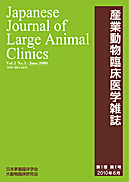A 10-year-old Japanese Black cow was presented for prolonged gestation and underwent induced parturition in April 2016. Because of a previous history of theileriosis, a hematological examination was performed. A blood sample collected in a vacuum tube for serum separation showed delayed blood clotting, and the blood smear revealed microorganisms on the surface of the red blood cells (RBCs). On the basis of these findings, hemoplasmosis was suspected. No clinical symptoms were evident, and RBC count, hematocrit and hemoglobin concentration were within the lower reference ranges immediately before parturition and until two days after parturition. Candidatus Mycoplasma haemobos was detected from a blood sample by real-time polymerase chain reaction(PCR). The percentage of pathogen-positive RBC was highest(23.9%)a day before parturition and subsequently declined, accompanied by normalization of the blood clotting time a day after parturition. The percentage of eosinophils also decreased over time from the day before to immediately before parturition. In addition, blood smears immediately before parturition and up to two days after parturition showed the presence of Theileria sp. Although the immunosuppressed status in the peripartum period appeared to play a role in the presence of hemoplasma in blood, parasitemia was not observed in other PCR-positive cows raised on the same farm either before or after parturition.
View full abstract
